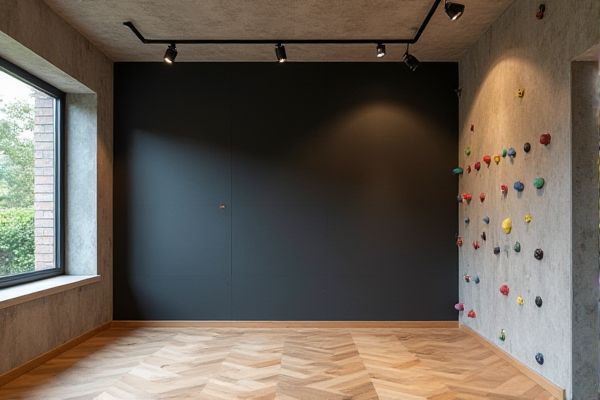
Choosing between an indoor climbing wall and a chalkboard wall in your basement depends on your space's purpose and your family's interests, offering either physical activity or creative expression. Discover the benefits and design tips for both options to make the most of your basement space. Read on to explore which choice suits your lifestyle best.
Table of Comparison
| Feature | Indoor Climbing Wall | Chalkboard Wall Basement |
|---|---|---|
| Purpose | Physical activity, strength training | Creative expression, note-taking |
| Space Requirements | Requires sturdy walls, moderate to large area | Minimal space, often a single wall |
| Installation Cost | High, due to materials and safety features | Low to moderate, mainly paint and supplies |
| Maintenance | Regular inspections for holds and anchors | Occasional cleaning and repainting |
| Functionality | Exercise and recreation | Writing, drawing, brainstorming |
| Safety | Requires safety gear, supervision recommended | Safe for all ages |
| Durability | Long-lasting with proper care | Can wear over time, repaint needed |
| Ideal For | Fitness enthusiasts, active families | Families, students, creative individuals |
Introduction: Comparing Indoor Climbing Walls and Chalkboard Walls
Indoor climbing walls offer physical exercise, strength building, and fun challenges, while chalkboard walls in basements encourage creativity, brainstorming, and family interaction through drawing or writing. Your choice depends on whether you prioritize active movement and fitness or artistic expression and communication. Both options transform a basement into an engaging space tailored to different lifestyle needs.
Space Requirements for Each Wall Option
Indoor climbing walls typically require more vertical space, often needing ceiling heights of at least 10 to 12 feet to allow for safe climbing and proper holds installation. Chalkboard walls demand less space, as they are flat surfaces ideal for writing or drawing without the need for extensive structural support or clearance. Your choice depends on available basement dimensions, with climbing walls better suited for larger, taller areas and chalkboard walls fitting compact or multifunctional spaces.
Safety Considerations: Climbing vs. Chalkboard Walls
Indoor climbing walls require rigorous safety measures, including secure anchor points, crash pads, and proper supervision to prevent falls and injuries. Chalkboard walls in basements pose minimal physical hazards but may involve potential dust inhalation from chalk powders, necessitating adequate ventilation. Both options must consider material durability and user behavior to ensure a safe environment.
Cost Analysis: Installation and Maintenance
Indoor climbing walls typically require higher initial installation costs due to specialized materials, professional assembly, and safety features, whereas chalkboard walls in basements are more budget-friendly with basic painting or paneling expenses. Maintenance for climbing walls involves regular inspections, holds replacement, and surface cleaning to ensure safety, making ongoing costs relatively higher compared to chalkboard walls that require minimal upkeep, such as occasional cleaning or repainting. Your choice depends on balancing upfront investment against maintenance demands and intended usage frequency.
Benefits for Children's Development
Indoor climbing walls enhance children's motor skills, balance, and coordination while promoting physical fitness and confidence. Chalkboard walls foster creativity, fine motor skills, and cognitive development through drawing and writing activities. Both options support emotional growth by encouraging problem-solving and self-expression in a safe, engaging environment.
Creative Design and Customization Ideas
Indoor climbing walls in basements offer versatile creative design options such as customizable routes, varying hold shapes, and vibrant color schemes to match personal style and skill levels. Chalkboard walls provide a unique surface for artistic expression and practical use, allowing for dynamic drawings, notes, and inspirational messages that can be changed regularly. Both options can be tailored with lighting accents, themed decor, and integrated storage solutions, enhancing functionality and aesthetic appeal.
Suitability for Different Age Groups
Indoor climbing walls cater to a wide range of age groups, offering adjustable difficulty levels and safety features that make them ideal for children, teens, and adults seeking physical activity and skill-building challenges. Chalkboard walls provide versatile creative space suited especially for younger children and families who enjoy drawing, writing, and interactive play within the basement environment. Your choice between these options depends on whether you prioritize dynamic physical engagement or imaginative, artistic expression for varied age groups.
Long-Term Value and Flexibility
Indoor climbing walls offer substantial long-term value by promoting physical fitness, coordination, and mental challenge, making them an active investment for health-conscious homeowners. Chalkboard walls provide versatile functionality, serving as creative outlets, planning spaces, or educational tools, adaptable to changing household needs over time. Both installations enhance basement usability, with climbing walls suited for dynamic exercise and chalkboards for ongoing family interaction and organization.
Parental Supervision and Involvement
Indoor climbing walls in basements require active parental supervision to ensure children's safety and proper use, promoting physical activity and skill development. Chalkboard walls encourage creativity and learning through guided activities, making parental involvement essential for educational engagement and monitoring. Both options benefit from consistent adult presence to foster a safe, interactive, and developmental environment.
Final Verdict: Choosing the Best Wall for Your Basement
Choosing between an indoor climbing wall and a chalkboard wall for your basement depends on your lifestyle and space preferences; an indoor climbing wall offers physical fitness benefits and an engaging activity, while a chalkboard wall provides a creative and flexible surface for drawing, writing, or planning. Indoor climbing walls require more installation space and safety considerations, whereas chalkboard walls are easier to install and maintain, making them suitable for family use or home offices. Your decision should reflect whether you prioritize active recreation or interactive creativity in your basement environment.
 homyna.com
homyna.com